Tratamiento y control de las infecciones por Mycoplasma gallisepticum y Mycoplasma synoviae con Fumarato Hidrogenado de Tiamulina sola y en combinación con Doxiciclina
El Mycoplasma gallisepticum(MG), es uno de los patógenos más importantes en las aves, Por ser el causante de la Enfermedad Respiratoria Crónica Complicada(ERCC), Para controlar el impacto de esta enfermedad, se han usado programas de medicación de control y tratamiento con Fumarato Hidrogenado de Tiamulina (FHT) y Doxiciclina. El FHT es una pleuromutilina que ha demostrado tener un fuerte efecto contra el MG, Por otro lado la Doxiciclina además de poseer una alta liposolubilidad que garantiza una buena absorción, genera un efecto Mycoplasmicida. El objetivo de esta revisión sistemática es establecer el análisis del perfiles PK/PD (farmacocinética/farmacodinamica) de cada antibiótico frente a la Concentración Minima Inhibitoria (MIC) de Mycoplasma gallisepticum, Las conclusiones de este trabajo de investigación es que ambos antibióticos están clasificados como concentración-dependiente, su actividad mycoplasmicida depende de la concentración en los tejidos, por lo tanto uno de los parámetros más adecuados para su análisis de PK/PD es el AUC/MIC (área bajo la curva en el tiempo/concentración mínima inhibitoria), El análisis sistemático arrojo que el FHT a una dosis de 25 mg/k presenta un AUC/MIC = 351, y para la Doxicilina a 20mg/k fue AUC/MIC = 1713, según la recomendación de la farmacopea un fármaco que supere AUC/MIC >300 ejerce un efecto bactericida, En dicha revisión observamos la potencia de los antibióticos al analizar el parámetro PK/PD, Cmax /MIC(concentración máxima /MIC), que arroja la potencia del antibiótico, Para FHT el Cmax /MIC = 60 , y para Doxiciclina Cmax /MIC = 1694 veces más potente a la dosis usada, se reportó que al usar una mezcla de FTH+Doxiciclina se logró disminuir la mortalidad por Escherichia coli además en un 10%.
Palabras claves. PK/PD, FHT, AUC/MIC, Cmax /MIC, Mycoplasma gallisepticum
Las infecciones por Mycoplasmas pueden causar grandes pérdidas en las aves, Estas tienen la característica de desencadenar una Enfermedad Respiratoria Crónica Complicada(ERCC), que puede ser resistente a los antibióticos, Sin embargo varios estudios han demostrado que el Fumarato Hidrogenado de Tiamulina (FHT), es activo contra varias especies de Mycoplasmas spp.
Los Mycoplasmas son bacterias muy pequeñas, que carecen de pared celular y se caracteriza por poseer un genoma pequeño[1], Son resistentes a los antibióticos que actúan inhibiendo la síntesis de la pared celular, Recientes trabajos de investigación sugieren que el Mycoplasma gallisepticum(MG) sobrevive por largos periodos de tiempo fuera del hospedador, en el pasado se creía que esto no era posible[2], Su genoma se caracteriza por tener un tamaño de 580 – 1,350 kb (E. Coli y la Salmonella spp tiene un tamaño alrededor de 4,000 kb), para su crecimiento requiere esteroles y una temperatura de 37 C[3].
Efecto | Mg | Ms | Mm | Mi |
Sinusitis | ++ | + | - | - |
Neumonía | ++ | +/- | - | - |
Aerosaculitis | ++ | + | + | + |
Sinovitis | - | ++ | - | + |
Artritis | - | ++ | - | + |
Condrodistrofia | - | - | + | + |
Meningitis | + | + | - | - |
Diminución producción huevos | ++ | +/- | - | - |
Mortalidad Embrionaria | + | +/- | + | + |
Disminución de incubabilidad | + | +/- | + | + |
Reducción del crecimiento | ++ | + | + | - |
Reducción ganancia de peso | - | - | + | + |
| Kleven et al., 1998[4] Clasificación de las lesiones en la leyenda: ++=Severa; +=Moderada; +/-=Media; - =Ausente |
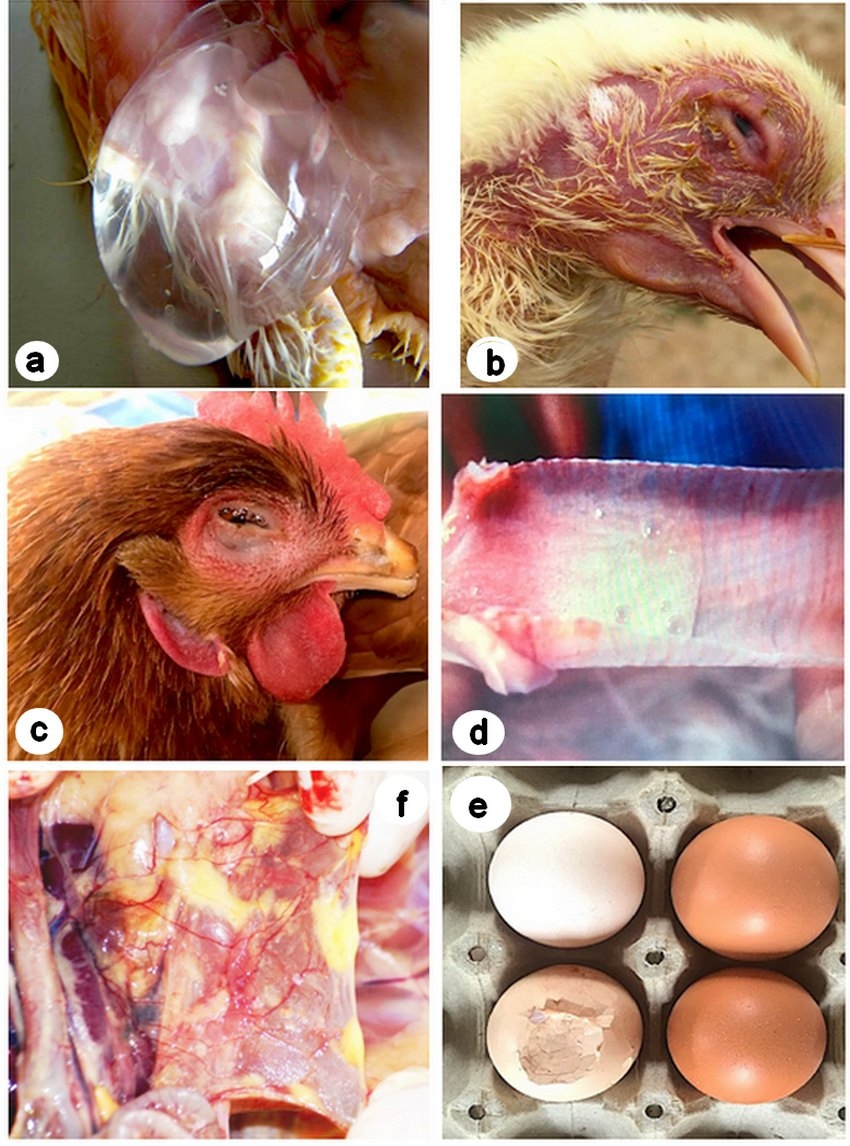
(a) saco aéreo abdominal limpio,(b) Conjuntivitis ave de 27 días por MG, (c)Sinusitis ave de postura 23 semanas(MG), (e)aerosaculitis ++ por MG(ERCC) pollo de 28 días, (f) Fragilidad en cascara ave de postura 53 semanas por MS. Fotografías John Jairo Salazar MVZ.
El Fumarato Hidrogenado de Tiamulina (FTH): (14-deoxi 14 [(2-dietylaminoethyl)-mercapto-acetoxi] mutilin fumarato hidrogenado), es un derivado semisintetico de las pleuromutilinas(Pleurutus mutilis), Es un Diterpenico poli cíclico(20 carbonos) con presencia de 3 anillos hidrocarbonados, Cicloexanos, Ciclopentanos, y anillos aromático[6]

Figura Nº1. Composición química del Fumarato Hidrogenado de Tiamulina Klein, U.(2013)Pig & Poultry symposium, Novartis[7]
La correlación entre la Farmacocinética/Farmacodinamica (PK/PD) se ha convertido en una herramienta importante para lograr la terapia exitosa de FHT,
Índice PK/PD | Definiciones | Unidades | Referencia |
Farmacodinamica(PD) | |||
MIC | Concentración mínima inhibitoria más baja, a la que el antibiótico inhibe el crecimiento de la bacteria | µg/ml | Mounton et al., 2005[12] |
MBC | Es la concentración más baja a la que se elimina el 99.9% de las bacterias | µg/ml | Taylor et al., 1983 [13] |
Farmacocinética(PK) | |||
AUC | Área bajo la curva de concentración en 24 horas en estado estacionario. Equivalente a una dosis de AUC 0-∞ | µg/ml | Mounton et al., 2005[12] |
ƒ | Prefijo de farmacocinética del índice PK/PD del a fracción libre del antibiótico | ||
CMax | Mayor concentración de medicamento estimada en el compartimento de referencia | µg/ml | Mounton et al., 2005[12] |
Correlación PK/PD | |||
T>MIC | % acumulado en un periodo de 24 hs. en el cual la concentración del MIC excede la condición de la farmacocinética | % | Mounton et al., 2005[12] |
AUC/MIC | Área de concentración del medicamento en el tiempo/MIC | Mounton et al., 2005[12] |
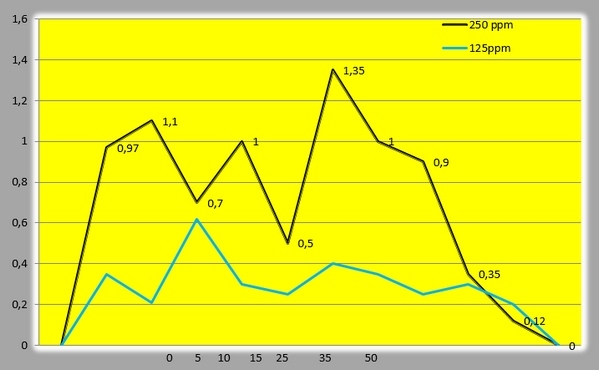
Figura Nº 2. Parámetros de farmacocinética (PK) para Fumarato Hidrogenado de Tiamulina. Ziv(1981).
Para alcanzar una cura en el paciente y lograr una alta probabilidad de curación microbiológica y clínica, se requiere de una exposición adecuada de las bacterias a el agente microbiano, La expo sisón depende de la dosis aplicada y la farmacocinética en el paciente, La exposición es la función de la susceptibilidad del patógeno dada por el MIC(Concentración Mínima Inhibitoria), La práctica optima de un fármaco será utilizar una dosis que sea capaz de alcanzar el objetivo farmacodinamico para una variedad de especies bacterianas, Para diferentes antimicrobianos estos enfoques están basados en la farmacocinética de la población y el análisis de la distribución del MIC, de una dosis para tratar una infección sistémica por un patógeno.
fu*F
MIC = Concentración Mínima Inhibitoria pata eliminar el microrganismo
CL= Eliminación del Medicamento en el cuerpo del paciente
fu= Fracción libre del medicamento en el Plasma
F= Biodisponibilidad del medicamento
Dosis Optima Tiamulina Mg (AUC 24/MIC) 125/h*(MIC 90) 0.031 µg/ml*CL 2.98 l/h/kg
Biodisponibilidad 0.9 (90%)
Biodisponibilidad 0.9 (90%)
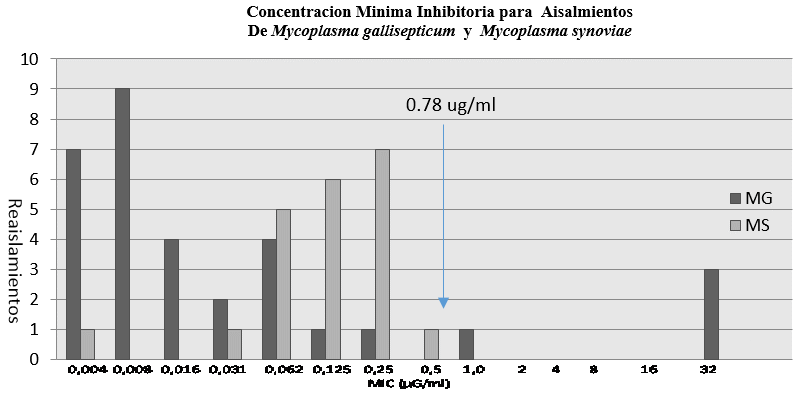
MG: Mycoplasma galllisepticum, MS: Mycoplasma synoviae [19]
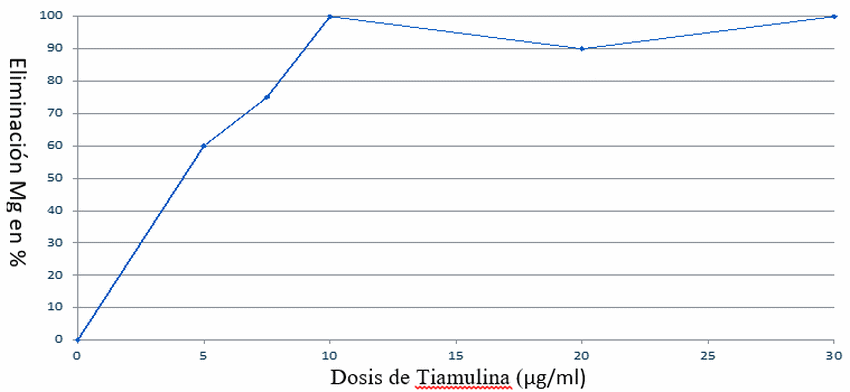
MG. Mycoplasma gallisepticum , MIC usado para este estudio fue 0.0039 µg/ml [14]

Autor (año) | Dosis(mg/kg) | Vía | Cmax(µg/ml) | MIC(µg/ml) |
Ziv (1981) | 12.5 | Agua | 0.5 | 0.25 |
Ziv (1981) | 25 | Agua | 1.4 | 0.25 |
Xiao (2016) | 12.5 | IM | 2.62 | 0.25 |
Xiao (2016) | 25 | IM | 5.48 | 0.25 |
Burch (1982) | 20 | Alimento | 1.7 | 0.25 |
Doxiciclina Hiclato
La Doxiciclina (œ-6-deoxy-5-hidroxitetraciclina), es la segunda generación de las tetraciclinas, Posee una alta liposolubilidad relativa (5- 10 en relación con otras tetraciclinas), el cual logra una absorción activa compensada con una alta unión a las proteínas plasmáticas[21], Principalmente es activa contra bacterias Gram positiva y Gram negativas aeróbicas y anaeróbicas, Spirochetas, Mycoplasmas spp, Riketsias, Cladmmydia tracomatis, Ureoplasmas [22].
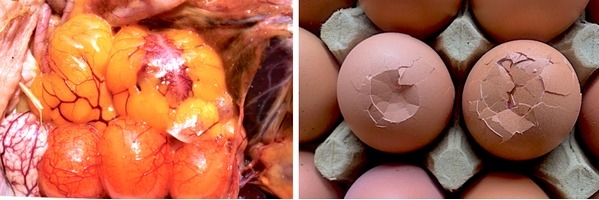
(a) Ovo peritonitis(Salmonella gallinarum) (b) Ápice fracturados por Mycoplasma synoviae
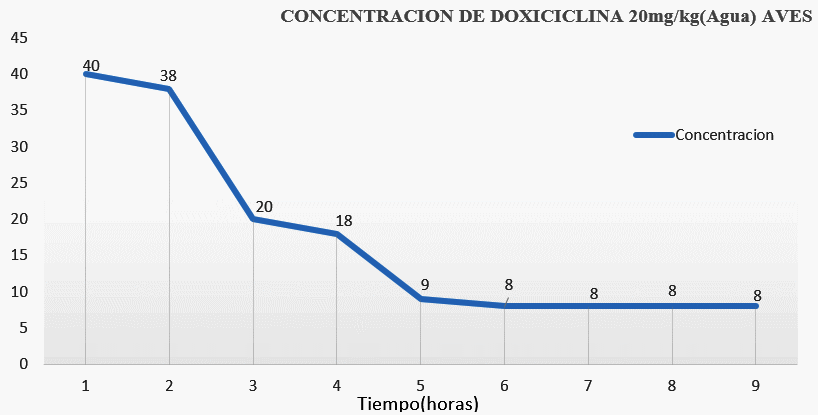
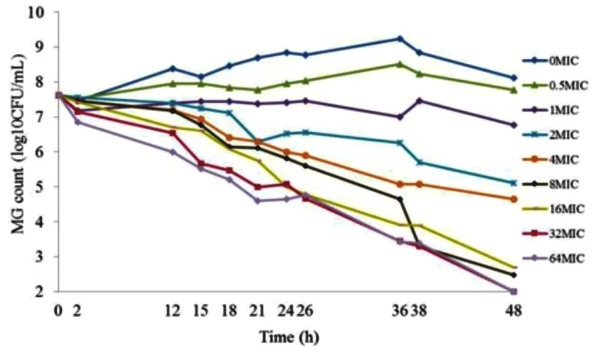
Correlación PK/PD | Tiamulina(FHT) Agua 25 mg/k | Doxiciclina Agua 20 mg/k |
AUC (µg/ml-hr) | 13.72 | 214.21 |
MIC (µg/ml) | 0.039 | 0.125 |
AUC/MIC(µg/ml-hr) | 351 | 1713 |
AUC= Área bajo la curva, MIC= Concentración Mínima inhibitoria, AUC/MIC= Área bajo la curva /concentración mínima inhibitoria. AUC Doxiciclina, Fumarato Hidrogenado de Tiamulina en Aves-Agua |
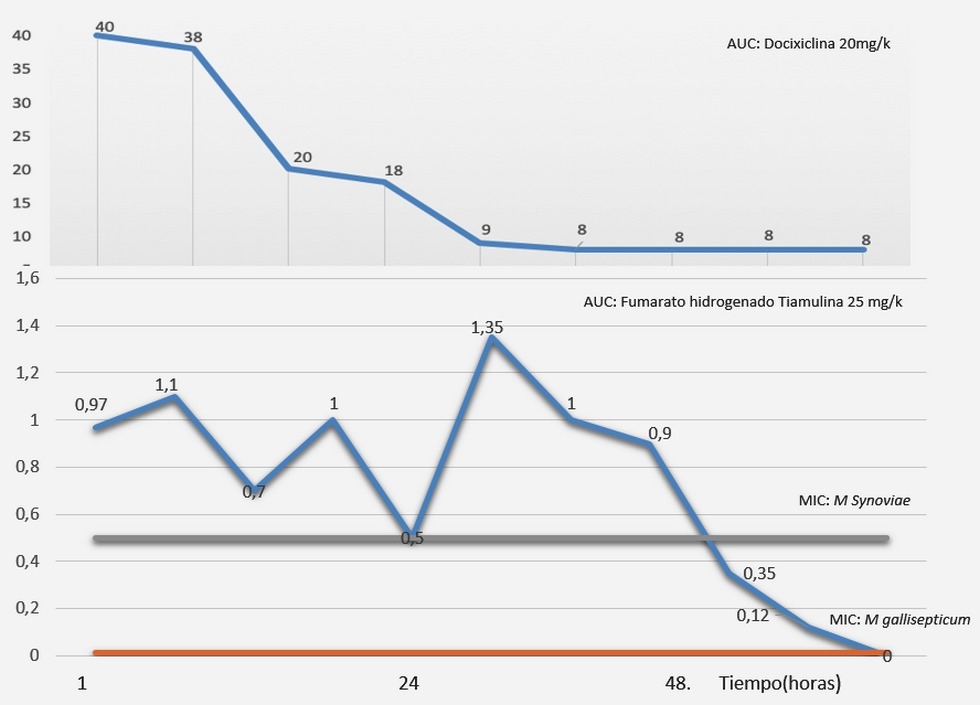
Figura Nº 7 Parámetros de Farmacocinética/Farmacodinamica para la mezcla de Fumarato Hidrogenado de Tiamulina y Doxiciclina frente a las cepas de referencia S6 de Mycoplasma gallisepticum.
Discusión
Grupo Tratado (ppm) | Mortalidad (%) | Nº Aves en que se aisló E.Coli de hígado |
Testigo no Tratado | 10(33.0) | 8 |
FHT | 6 (20) | 5 |
Doxiciclina 50 ppm | 7 (23.3) | 6 |
FHT 33/OTC 100 | 5 (16.7) | 3 |
FTH 66/OTC 200 | 3 (10.0) | 2 |
FTH: Fumarato Hidrogenado de Tiamulina, Doxiciclina, ppm: partes por millón. |
[1] Razin, S., D. Yogev, and Y. Naot. 1998. Molecular biology and pathogenicity of mycoplasmas. Microbiol. Mol. Biol. Rev. 62:1094-1156.
[2] Christensen, N. H., C. A. 1994 Yavari, A. J. McBain, and J. M. Bradbury. Investigations into the survival of Mycoplasma gallisepticum, Mycoplasma synoviae and Mycoplasma iowae on materials found in the poultry house environment. Avian Pathol. 23:127-143.
[3] Baseggio, N., M. D. Glew, P. F. Markham, K. G. Whithear, and G. F. Browning. 1996. Size and genomic location of the pMGA multigene family of Mycoplasma gallisepticum. Microbiol 142:1429-1435.
[4] Kleven, S. H. 1998. Mycoplasmosis. In: A Laboratory Manual for the Isolation and Identification of Avian Pathogens, Fourth Edition, Four ed. D. E. Swayne, J. R. Glisson, M. W. Jackwood, J. E. Pearson and W. M. Reed, eds. American Association of Avian Pathologists, Kennett Square, PA. pp 74-80.
[5] Ley, D. H. 2003 .Mycoplasma gallisepticum infection. In: Diseases of Poultry, 11 ed. Y. M. Saif, H. J. Barnes, J. R. Glisson, A. M. Fadly, L. R. McDougald and D. E. Swayne, eds. Iowa State University Press, Ames, Iowa. pp 722-744.
[6] Islam, K. M., U. Klein, and D. G. Burch. 2009. The activity and com- patibility of the antibiotic tiamulin with other drugs in poultry medicine – Review. Poult. Sci. 88:2353–2359.
[7] Klein, U. 2013 . Pig & Poultry Symposium-Denagard –update formulations- Specific Characteristcs in relation to Poultry disease treatment-Preceddigs Novartis Cancun.
[8] Katzung, Bertram G. 2007. «Chapter 44. Chloramphenicol, Tetracyclines, Macrolides, Clindamycin, & Streptogramins.». Basic & Clinical Pharmacology (9 edición). McGraw-Hill. ISBN 0071451536..
[9] Valks, M.D., D.G.S Burch. 2002. Comparative activity and resitence developmentnt and tiamulin and others antimicrobials to Mycoplasmas in poultry.Page 200 preceedingng The Cairo.
[10] Ijaz Ahmad, Lingli Huang, Haihong Hao, Pascal Sanders, and Zonghui Yuan 2016. Aplication of PK/PD Modeling in Veterinary Field: Does Optimization Drug Resistence prediction. BioMed Research International?Volume 2016, Article ID 5465678, 12 pages http://dx.doi.org/10.1155/2016/5465678.
[11] Pridmore, A. 2016. MycoPath I Report – MIC determinations of European Collection of Mycoplasma pathogens. Vet Microbiol 188-193
[12] J. W. Mouton, M. N. Dudley, O. Cars, H. Derendorf, and G. L. Drusano, 2005 .“Standardization of pharmacokinetic/pharma- codynamic (PK/PD) terminology for anti-infective drugs: an update,” Journal of Antimicrobial Chemotherapy, vol. 55, no. 5, pp. 601–607.
[13] P. C. Taylor, F. D. Schoenknecht, J. C. Sherris, and E. C. Linner, 1983. “Determination of minimum bactericidal concentrations of oxacillin for Staphylococcus aureus: influence and significance of technical factors,” Antimicrobial Agents and Chemotherapy, vol. 23, no. 1, pp. 142–150.
[14] Burch. D., Klein. U 2017. Dose optimization of tiamulin(Denagard) for the metaphylaxis treatment of Mycoplasma gallisepticum in infections chikens. Elanco Animal Health , Elanco Animal Health, Schwarzwaldalle215, CH-4058 Basel, Switzerland. Octagon Services Ltd, Friary Round House, Old Windsor, Berkshire, SL42NR, United Kingdom .
[15] Laber.G.,& Schutze. E. 1977. In Vivo Efficacyof81.723hfu, a New Pleuromutilin Derivative Against Experimentally Induced Airsacculitis in Chicks and Turkey Poults. The Journal antibiotics, 30, 12, 119.
[16] Ziv. G. 1980. Preliminary clinical pharmacological investigations of tylosin and tiamulin in chickens, Veterinary Quarterly, 2:4, 206-210, DOI 10.1080/01652176.1980.9693782:https://doi.org/10.1080/01652176.1980.9693782.
[17] Xia Xiao , Jian Sun , Tao Yang, Xi Fang, Jie Cheng, Yan Q. Xiong3 and Ya-Hong Liu, 2016 Pharmacokinetic/Pharmacodynamic ProfilesTiamulin in an Experimental Intratracheal Infection Model of Mycoplasma gallisepticum Veterinary Science Vol 3, 75
[18] Hannan., P.C., Windor.G.D., Jong.D.A., Scheemer.N., and Stegman 1997 Comparative suceptibilities of Variuos- Phatogenic Mycoplasmas to fluorquinolones. Antimicrobial agents and chemioteraphy, Sept. 1997, p. 2037–2040
[19] Burch .D 1982. Review of the activity of antibiotics against Mycoplasma spp and their use in the prevention of vertical transmission in breeder layers Squib Inform Octagon Services Ltd, Old Windsor, Berkshire, UK
[20] Mostafavi SA, Foster AT. 2020. A double-peak phenomenon in the pharmacoki- netics of acebutolol enantiomers after oral administration: discontinuous absorption of acebutolol. Daru J Faculty Pharm 10(4):141–7
[21] Barza, M., Brown, R.B., Shanks , C , Gambel , G . & Wenstesrtein, L . 1975. Relation between lipophilicity and pharmacological behaviour ofminocycline, doxycycline, tetracycline and oxytetracycline in dogs. AntimicrobialAgentsandChemotherapy,8,713-720
[22] Riond, J.L., Tyczkowska, K. & Riviere, J.E. 1989. Pharmacokinetics and metabolic inertness of doxycycline in calves with mature or immature rumen function. AmericanJournal of Veterinary Research, 50, 1329-133?
[23] Goren, E., Dejong, W.A., Doornelband, P. & Laurense, T. 1988. Therapeutic efficacy of doxycy- cline hyclate in experimental Escherichia coli infection in broilers. The Veterinary Quarterly, 10,48-52
[24] Sumano. H., & Gutiérrez. L 2005. Tetraciclinas, Farmacología clínica de las aves. Pp 81-82
[25] Anadon,A., Martinez-Larrañaga, M.R., Díaz, M.J., Bringas, M.C., Fernández., Iturbe,J. 1994 . Pharmacokinetics of doxycycline in broiler chikens. Avian Pathology 23, 79-90
[26] Zhang N., Xiayang, G., Xun, W., Longfei, Z., Xiangguand, S., Hongxia, J., Huanzhong, D. 2016. The Pk/PD Interactions of Doxycycline against Mycoplasma gallisepticum. Frontiers in Microbiology 7, 653
[27] Michael, G., Mosser, J. & Olle, J. 1984. Pharmacokinetics and tissue localization of doxycycline polyphosphate and doxycycline hydrocloride in the rat. European Journal of Drug Metabolism and Pharmacokinetics, 2, 149-15?
[28] Riond, J.L. & Rivere, J.E. 1988. Pharmacology and toxicology of doxycycline. Veterinary andHuman Toxicology, 30,431-44. ?
[29] Nikolas J. Onufrak, PharmD, Alan Forrest, PharmD, and Daniel Gonzalez, PharmD, PhD. 2016. Pharmacokinetic and Pharmacodynamic Principles of Anti- Infective Dosing. Clin Ther. 38(9): 1930–1947. doi:10.1016/j.clinthera.2016.06.015.
[30] Burch. D.G.S & Roberta Alvarez. Octagon Services Ltd, Old Windsor, Berks, UK 2004. Cmax and AUC/MIC Raltion for tiamulin prevention and control of Mycoplasma gallisepticum. Novartis Animal Health, Basel, Switzerland?[Paper presented at the 2nd International Conference on Antimicrobial Agents in Veterinary Medicine, Ottawa Canada p 29].
[31] Szathmary. S 2006. Inmunología de las infecciones por Mycoplasma y su influencia en la respuesta inmune contra infecciones virales y otras Co-infecciones. Novartis Poultry Simposio, New trends of Mycoplasma and Coccidia control. Sep 9
[32] Drlica, K. 2003 The mutant selection window and antimicrobial resistance. Journal of Antimicrobial Chemotherapy, 52, 11-17?
[33] Valks .M., 2006. Experiencias en el control del Mycoplasma. Novartis poultry symposium. New trends of Mycoplasma and Coccidia Control.
[34] Mouton, J. W., M. N. Dudley, O. Cars, H. Derendorf, and G. L. Drusano, 2005 “Standardization of pharmacokinetic/pharma- codynamic (PK/PD) terminology for anti-infective drugs: an update,” Journal of Antimicrobial Chemotherapy, vol. 55, no. 5, pp. 601–607.
[35] Potter, J. Illambas, L. Pelligand, A. Rycroft, and P. Lees, “Erratum to 2013 ‘pharmacokinetic and pharmacodynamic integra- tion and modeling of marbofloxacin in calves for Mannheimia haemolytica and Pasteurella multocida’ [The Veterinary Journal 195 (2013) 53–58],” The Veterinary Journal, vol. 196, p. 218
[36] Mouton, J. W., D. F. J. Brown, P. Apfalter et al., “The role of 2012 pharmacokinetics/pharmacodynamics in setting clinical MIC breakpoints: the EUCAST approach,” Clinical Microbiology and Infection, vol. 18, no. 3, pp. E37–E45
[37] W. A. Craig, 1998 “Pharmacokinetic/pharmacodynamic parameters: rationale for antibacterial dosing of mice and men,” Clinical Infectious Diseases, vol. 26, no. 1, pp. 1–12
[38] McKellar, Q.A., S. F. Sanchez Bruni, and D. G. Jones, “Phar- 2004 macokinetic/pharmacodynamic relationships of antimicrobial drugs used in veterinary medicine,” Journal of Veterinary Pharmacology and Therapeutics, vol. 27, no. 6, pp. 503–514
Dr. Humberto, Agradezco su comentario, el objetivo del articulo es profundizar en el concepto de farmacocinetica y farmacodinamica de la sinergia, y hasta donde se puede aprovechar esa sinergia en el tratamiento y control de los Mycoplasmas Spp.
Un articulo bastante explicito y de mucho interés, mi agradecimiento a los Autores por el tema.
Reciban un cordial saludos desde Culiacán, Sinaloa, México


Antibióticos en la producción animal: Joaquim Brufau (IRTA)


















